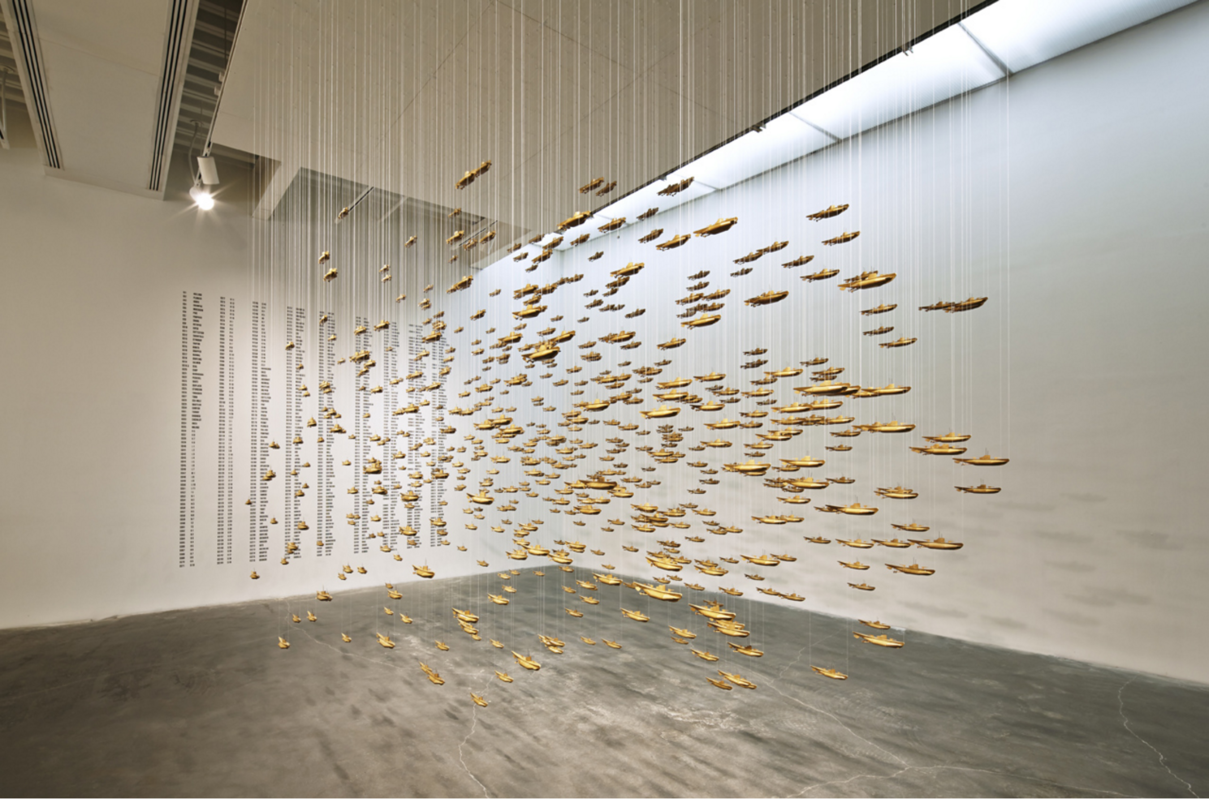More about All the Submarines of the United States of America

Contributor
Reminiscent of a school of tiny brown fish, this installation is actually a cloud of 625 miniscule cardboard submarines.
There’s one for each submarine of the US naval fleet from the 1890s (when submarines first entered the naval arsenal) to the 1980s. Their names are meticulously listed on the wall behind the fleet (the clear winners bring the USS Unicorn and the Intelligent Whale).
Kind of funny that after dedicating the first part of his career to highly dangerous performance art (think getting intentionally shot in the arm with a rifle, crawling across broken glass on national TV, and being nailed to the hood of a Volkswagen), so much of Burden’s later sculpture involves playing with toys. I’d wager that Matchbox cars, action figures, and model submarines were a refreshing alternative to painful bodily injury.
It’s actually not that much of a leap from his performance art to his sculpture, though. “I was trained as a minimalist artist,” Burden said in a 2013 interview. “To see sculpture you have to move around it, and I was trying to boil it down to the core. I thought, ‘If the core is forcing people to move, then maybe that is where the art is.’ That is how I arrived at doing performances.” So if a=b, and b=c…
What’s the point of all these little cardboard -floaty guys? A lot of Chris Burden’s work poses questions about power and authority. Completed in 1987, this installation was born towards the end of the Cold War. At its unveiling, it would have been a timely reflection on the comforting security/creepy omnipresence/terrifying scale (depending on how you slice it) of US military might.
Sources
- “All the Submarines of the United States of America,” Dallas Museum of Art. Accessed Jan 30, 2017. https://www.dma.org/collection/artwork/chris-burden/all-submarines-unit…
- Benjamin Sutton, “Chris Burden, Pioneering Performance Artist and Large-Scale Sculptor, Dead at 69.” Hyperallergic. May 10, 2015. Accessed January 30, 2017. http://hyperallergic.com/205892/chris-burden-pioneering-performance-art…
- Chris Burden and Jarrett Earnest, “Applying Pressure: Chris Burden with Jarrett Earnest.” The Brooklyn Rail. November 5, 2013. Accessed January 30, 2017. http://brooklynrail.org/2013/11/art/applying-pressurechris-burden-with-…
- “Ships of the US Navy, 1940-1945.” Accessed January 30, 2017. https://www.ibiblio.org/hyperwar/USN/ships/SS/SS-436_Unicorn.html
- “The Untold Story of Intelligent Whale.” Undersea Warfare. Accessed January 30, 2017. http://www.public.navy.mil/subfor/underseawarfaremagazine/Issues/Archiv…











